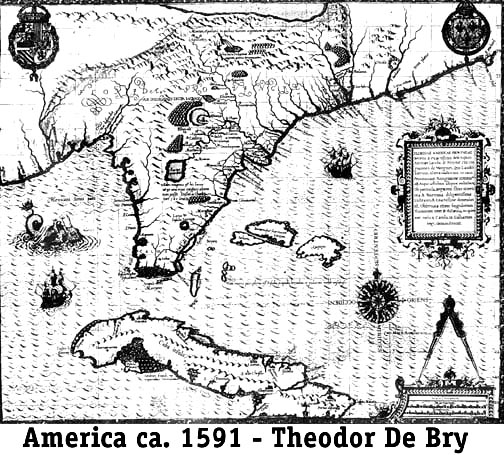|
THE FLORIDA ROOM
Welcome to the History of Florida
Page 1
This page by Jerry Wilkinson
(This is a sample and incomplete cybermuseum
page. Remember to click on the image to enlarge and that a "photo is worth
a thousand words," so pay attention to subtle details.
J.W.)
 Not only did Florida look this that long ago,
the Florida Keys did about 100,000 years ago and this is the approximate
age of Key Largo Limestone and Miami Oolite. As the polar glacier reformed
the seawater level dropped killing the corals. The ocean began rising about
15,000 years ago.
Not only did Florida look this that long ago,
the Florida Keys did about 100,000 years ago and this is the approximate
age of Key Largo Limestone and Miami Oolite. As the polar glacier reformed
the seawater level dropped killing the corals. The ocean began rising about
15,000 years ago.
 Florida received its name when Ponce de Leon
landed on its northeast coast in the spring of 1513. From the chart above
one can follow his journey southward along the Florida east coast and past
the Keys. According to Antonio Herrera, Ponce's biographer, he named the
Keys "Los Matires", translated means the martyrs.
Florida received its name when Ponce de Leon
landed on its northeast coast in the spring of 1513. From the chart above
one can follow his journey southward along the Florida east coast and past
the Keys. According to Antonio Herrera, Ponce's biographer, he named the
Keys "Los Matires", translated means the martyrs.
 Most libraries will have a readable copy of
this map. It is only presented to depict the geographical concept of Florida
in early times. Theodor De Bry spent considerable time in the Jacksonville
sketching the native Timucian Indians.
Most libraries will have a readable copy of
this map. It is only presented to depict the geographical concept of Florida
in early times. Theodor De Bry spent considerable time in the Jacksonville
sketching the native Timucian Indians.

This is one of Theodor De Bry's sketches of the Timucians.
 Another map depicting the perceived size of
Florida. The Spanish claimed from the Rio de Grande River to about the
Cheasapeake Bay area.
Another map depicting the perceived size of
Florida. The Spanish claimed from the Rio de Grande River to about the
Cheasapeake Bay area.
 The early history of Florida was strictly maritime
and Native Americans. Ponce de Leon had discovered the northward flowing
Gulf Stream and it became the maritime highway of the time. Frenchman,
Jean Ribault established Fort Caroline on the banks of the St. Johns river
in 1562, but it was later destroyed. The Spanish owned St. Augustine survived
to be America's oldest surviving permanently settled community.
The early history of Florida was strictly maritime
and Native Americans. Ponce de Leon had discovered the northward flowing
Gulf Stream and it became the maritime highway of the time. Frenchman,
Jean Ribault established Fort Caroline on the banks of the St. Johns river
in 1562, but it was later destroyed. The Spanish owned St. Augustine survived
to be America's oldest surviving permanently settled community.

Another later map showing the immense size of Spanish Florida.
Continued on Page 2
Go to Page 2
Return to Florida Page 1
|